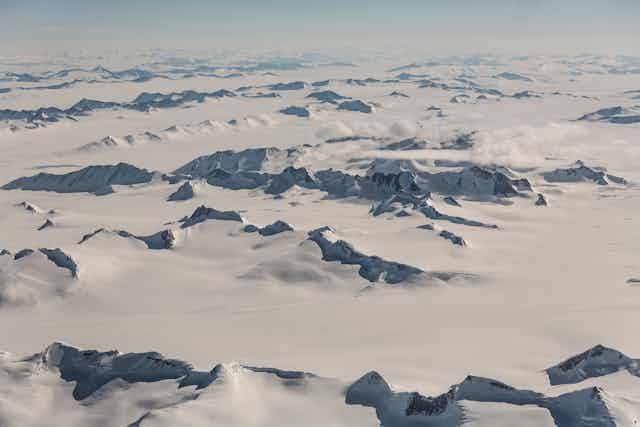Glaciers have been present somewhere on Earth for at least 60 million years, a period stretching back almost to the time of the dinosaurs. That’s the key finding of our new research, which pushes the date when the planet was last glacier-free back by at least 26 million years.
It may not feel like it due to profound recent warming, but Earth is currently in an “icehouse phase” – at least, relative to its long-term geological history. Even after a century of global warming and many glaciers shrinking or disappearing, conditions are still cold enough to support permanent ice sheets at both poles and more than 200,000 glaciers at high and low elevations and latitudes across the planet. This has not always been the case.
In the geological past Earth was much warmer and glaciers were almost certainly absent even from the very highest and coldest mountains. This is perhaps best demonstrated by the Late Cretaceous period (some 100 million to 66 million years ago), when dinosaurs roamed much of the planet and the climate was up to 20°C warmer than present. Then, the sort of “sub-tropical” forests you might find today in Mexico or India covered most of Antarctica.
As the climate cooled over the past 66 million years, Earth was pushed from a “greenhouse” into an “icehouse”, triggering ice ages and the growth of glaciers. The most dramatic cooling happened around 34 million years ago, when Antarctica first developed the ice sheets which now cover most of the continent in up to 4km of ice. However, it was less clear when the continent’s mountain glaciers first formed.

Our new study addresses this uncertainty by investigating when small glaciers first formed in the Transantarctic Mountains, a vast mountain chain that extends some 3,500km across the Antarctic continent. It is currently largely buried under the ice sheet but the areas which sit above the surface can be used to help understand when glaciers first appeared on the continent.
The onset of Antarctic glaciation
We used satellite images to map tens of thousands of glacial landforms, which can be valleys, cliffs, scratches in the rock or other features that have been formed at some point by glaciers. Given these are the world’s most remote and least hospitable mountains, mapping from satellite images in this way is far quicker than by visiting in person. But since the region is so big this still took more than a year of continuous work.
Our specific interest was in mapping glacial cirques, which are large glacially eroded bowl-shaped hollows (such as Cwm Idwal in North Wales, which was visited by Charles Darwin and helped convince him that the mountains of Britain once held glaciers). Using these cirques and our understanding of the climate conditions required for glaciers to form, we found that glaciers have likely existed in the highest mountains of Antarctica for at least the past 60 million years.

This is far earlier than reported by previous studies which suggest that mountain glaciers first developed just before 34 million years ago, immediately prior to the formation of the first ice sheet.
Our results instead indicate that Antarctica had glaciers even when it was much warmer than now and was mostly covered by dense sub-tropical forests. At the time, those were probably the only glaciers on Earth.
These high elevation mountain glaciers were likely swallowed up 34 million years ago by larger ice masses which eventually became a continent-wide ice sheet. It is likely that some mountain glaciers returned as the ice sheet retreated during the Miocene Climatic Optimum, a warm period some 15 million years ago, before a widespread switch to the sort of ice that continues to the present day.

